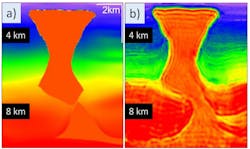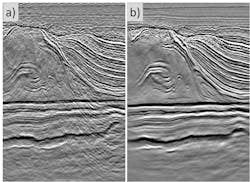New OBN imaging improves understanding of complex reservoirs
Risto Siliqi and Luke Twigger, CGG
The use of ocean bottom node (OBN) seismic is on the increase, with large-scale surveys designed to provide greater interpretation certainty in areas of complex geology, particularly in subsalt settings. The uptick in OBN projects encourages a likewise increase in related research. Processing and imaging of OBN data is a hot topic of discussion at conferences and workshops worldwide.
Complex reservoirs deserve better data
In areas such as the Gulf of Mexico or offshore Brazil, complex salt overburdens obscure the reservoir. The delineation and interpretation of salt boundaries in existing seismic images is very difficult and subjective. In addition to the complex salt geometry, poor illumination beneath a large salt canopy makes it very challenging to deliver a clear image of steep events truncated by salt. A low acoustic impedance contrast with surrounding high-velocity carbonates makes it yet more uncertain. Resolving salt misinterpretation would be impossible to achieve through tomography or manual interpretation methods. Indeed, it is difficult to overcome all these issues in the context of complex reservoirs using existing streamer data and conventional imaging technology.
In the context of complex geology, OBN acquisitions can provide much richer subsurface information than towed streamer datasets. This richness includes full-azimuth illumination of the subsurface with ultra-long offsets recording reflections and diffractions from complex geological bodies as well as the low-frequency wavefield diving deep below the overburden. Potential reservoirs embedded within complex geological settings have only faint seismic imprints in the OBN dataset. OBN imaging technology has the challenging task of extracting this information and revealing the true geological picture to asset teams.
Around the world OBN technology is being adopted where the technical limitations are considered to have been reached with towed-streamer datasets and business decisions require superior subsurface images to reduce risk. However, taking full advantage of this extra information requires both the expertise and the right technology to get the most from the investment in the survey.
Pioneering OBN imaging
With the rapid development of seismic imaging technology over the last decade, Full-Waveform Inversion (FWI) has emerged as a key technology. It has revolutionized velocity model building in complex settings, without the intrinsic bias of subjective structural interpretations, and delivered a big leap in seismic image quality when combined with the latest imaging algorithms, such as reverse time migration (RTM). This data-driven approach goes beyond earlier techniques that use only the kinematics of seismic data, by incorporating more information provided by the amplitude and phase of the seismic waveform. The resulting subsurface velocities are sufficiently detailed for the data simulated through the model to closely match the recorded seismic data. Many successful applications of FWI have been reported.
FWI is an ideal partner for OBN seismic. Noise-free low-frequency data help avoid classic FWI issues (such as cycle skipping between simulated and recorded data), while long offsets and full azimuths provide better illumination with diving waves and reflections to drive the algorithm.
However, standard FWI algorithms show limitations in the presence of strong velocity contrasts, such as salt diapirism. Cycle-skipping and amplitude discrepancies between the modeled and recorded data can, in these circumstances, confuse the algorithm and lead to biased and unrealistic velocity model results. Time-lag FWI (TL-FWI) is a newly developed algorithm (Zhang et al, 2018), specifically designed to overcome these issues, and therefore provide better results in complex salt environments compared to conventional FWI algorithms. TL-FWI considers both diving waves and reflections for modeling, allowing it to provide deeper model updates than standard FWI implementations. The time-lag aspect specifically refers to the strategy used to mitigate the problems of cycle-skipping and amplitude discrepancies. TL-FWI leads the way in updating complex salt models, producing more detailed and more accurate models for imaging algorithms. The benefits of TL-FWI can be clearly seen in the example from CGG’s OBN dataset in the Mississippi Canyon in the first image.
Even if excellent work is achieved with conventional velocity model building using the best tomography and salt body interpretation, data-driven model building can reveal greater detail in the geological layers and even redirect salt body interpretation.
Areas with complex overburdens pose significant challenges for imaging deep targets due to a lack of sufficient illumination. OBN seismic helps resolve these challenges, as the aforementioned rich azimuthal and offset coverage provides much more of the necessary illumination. However, RTM images still suffer from irregular illumination and migration artifacts originating from both the salt bodies and the small areal extent of the survey causing edge effects. An imaging process using a new least-squares RTM (LSRTM) approach was proposed to better handle these challenges (Wang et al., 2016). This inversion-based imaging algorithm estimates the inverse of the forward-modeling operator (i.e. the imprint of the migration process on the imperfect dataset), then applies this for different structural dips, frequencies and offsets to compensate for frequency-, angle- and offset-dependent illumination effects. Compared to RTM, LSRTM further improves the image with more balanced amplitudes, improved resolution, and an enhanced signal-to-noise ratio.
The same complex overburden geology is often responsible for strong generators of internal multiples. The presalt area of the Santos basin, offshore Brazil, is a good example of this scenario. Internal multiple attenuation (IMA) methods have been generalized to take advantage of OBN data (Pereira et al., 2019). This technique does not rely on identifying internal multiple generators, making it particularly useful for complex overburden geologies.
The second image illustrates the image uplift, in the Santos basin in Brazil, where CGG’s OBN imaging technology has been applied. The veil of internal multiples that pollutes the image and complicates fine-scale interpretation of the reflections is significantly attenuated. In addition, all the artificial swings introduced by conventional imaging algorithms are removed by the LSRTM inversion-based imaging approach.
After revealing the amplitudes of primaries by removing the corruption from internal multiples, LSRTM provides meaningful reflectivity of the images by suppressing various migration artifacts and compensating for irregular illumination caused by salt complexity or remaining demultiple imprints. Combining this innovative data-driven imaging technology with the use of OBN data can deliver reservoir-compliant images in a subsalt deepwater context.
A new horizon for complex reservoirs
Overcoming the challenges of imaging potential reservoirs embedded within complex geological settings requires the right data, the right imaging technology, and the right expertise. Developing imaging algorithms compatible with OBN data, or building inversion-based algorithms for model building and imaging are not the only challenges. Although modern techniques may appear to be “automatic,” successful delivery of images from a complex geological context requires expertise and attention to the finer detail. Understanding the geological complexity is the first important step. Elaborating the right algorithms and methodology to handle this specific complexity and recognizing the limitations remain fundamental. While remaining mindful of these challenges, the investment in OBN data will prove invaluable for the exploration and asset teams by revealing previously obscured reservoirs. This collaborative approach between the geological challenge and new OBN imaging guides the business model and strategy for OBN surveys.
Recent work has shown the justification for acquiring OBN surveys purely for the benefits in terms of salt delineation and velocity model building with TL-FWI in areas already comprehensively covered by multi- and wide-azimuth streamer datasets. The improvement in the velocity model can bring new life to the streamer data, providing an uplift in the image quality that can be achieved with the legacy datasets, especially when inversion-based imaging algorithms, such as LSRTM, are used. Optimization tests have been carried out using both synthetic and decimated field data in order to study and propose sparse node surveys to economically achieve this (Mei et al. SEG 2019).
Recent case studies have also shown that targeted, high-density OBN surveys around specific complex field structures (e.g. salt diapirs) can transform the detailed understanding of the reservoir structures to reduce the risk of field development and to help drive near-field exploration.
OBN surveys have been predominantly used on a proprietary basis, over limited areas closely focused on a particular reservoir or oil field. However, OBN is now beginning to be used in multi-client surveys and over much larger areas. The business case for this is justified. The multi-client model allows E&P companies to benefit from the economy of scale and license data at a lower unit cost, or license larger areas than they would normally acquire on a proprietary basis. For example, CGG and MagSeis Fairfield will soon start acquisition of an OBN survey, with strong industry backing, over some of the most geologically challenging areas of the UK central North Sea – the first phase alone covers about 2,500 sq km (965 sq mi) with preliminary results expected in early 2021.
Understanding the subsurface complexity, proposing solutions, and delivering on promises are today’s challenges for new OBN imaging. •
References
• Mei, J., Zhigang, Z., Lin, F., Huang, R., Wang, P., Mifflin, C., [2019] Sparse nodes for velocity: Learnings from Atlantis OBN full-waveform inversion test. 89th Annual International Meeting, SEG
• Pereira, R., Ramzy, M., Griscenco, P., Huard, B., Huang, H., Cypriano, L., and Khalil, A., [2019]: Internal multiple attenuation for OBN data with overburden/target separation. 89th Annual International Meeting, SEG
• Wang, P., Gomes, A., Zhang, Z. and Wang, M., [2016] Least-squares RTM: Reality and possibilities for subsalt imaging. 86th SEG Annual International Meeting
• Zhang, Z., J. Mei, F. Lin, R. Huang, and Wang P., [2018], Correcting for salt misinterpretation with full-waveform inversion. 88th Annual International Meeting, SEG

